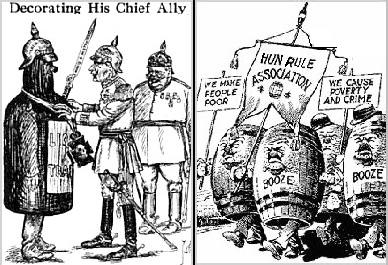As you are popping champagne corks tonight to herald in 2018, a big change in alcohol consumption was being proposed one hundred years ago. On December 18, 1917, the 18th Amendment, prohibiting the “manufacture, sale, or transportation of intoxicating liquors for beverage purposes,” was passed by Congress and sent to the states for ratification.
Prohibition had been on the minds of many Americans and their elected officials ever since Carrie Nation began swinging her ax in Kansas at the beginning of the century. Congressman Jouett Shouse (see Blog #11) was a Prohibition proponent and had spent much time the year before getting bills passed prohibiting alcoholic beverages in U.S. territories. The Anti-Saloon League wrote the following to him:
“The victories won, in which you had a large part, are, we hope, the earnest of still greater victories in the future, when the Resolution to submit the National Prohibition Amendment to the states for ratification will be adopted, in which also we confidently trust you will have a part.” (Kinsley Graphic, March 22, 1917)
Indeed, the Anti-Saloon League of Kansas arranged for a special train to run from Topeka to Washington, D.C. on December 8, 1917. “The idea is to make such a great demonstration at the national convention in Washington that Congress will be impressed and respond to the demands of the organization and put through national prohibition. It is on the way and coming fast.”(Kinsley Graphic, Nov. 22, 1917).
You might ask what prohibition has to do with World War I. Erik Kirschbaum, the author of “Burning Beethoven: The Eradication of German Culture in the United States during World War I” suggests that Anti-German sentiment helped to pass the 18th Amendment.
German immigrants and their descendants formed the largest ethnic group in the United States at the time. In 1901, the National German-American Alliance was formed to promote and preserve German culture in America. It essentially sought to resist the assimilation of Germans in America. At the peak of its growth, around 1916, the national organization had chapters in forty-five states, and the District of Columbia, and a membership of approximately 2.5 million people. Kirschbaum explains:
“The NGAA was funded in part by breweries and distilleries, and the organization devoted considerable time and effort to the battle against the Anti-Saloon League and that organization’s push for a national Prohibition….
“The prevailing anti-German sentiment galvanized opponents of alcohol in the U.S. The anti-Saloon League latched on to this unexpected opportunity to help its long-running but so far unsuccessful crusade to ban alcohol. Purley Baker, president of the Anti-Saloon League, attacked German-Americans as a ‘race of people who eat like gluttons and drink like swine,’ and the League was able to raise doubts about the loyalties of German brewers.”
The movement for Prohibition gained momentum when the United States entered the war and anti-German fever and distrust grew. Thirty-six 36 states ratified the amendment on January 17, 1920. It would remain the law until it was repealed in 1933 with the 21st Amendment.

